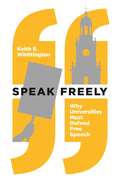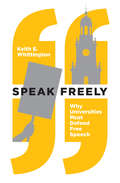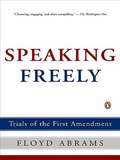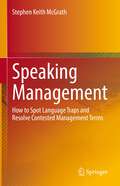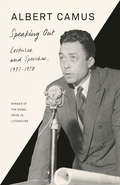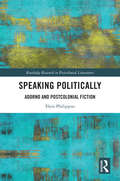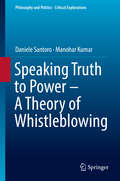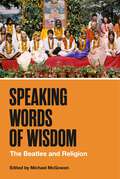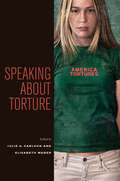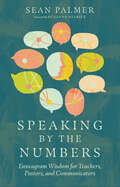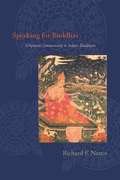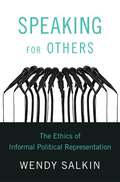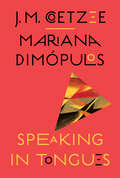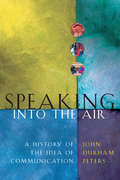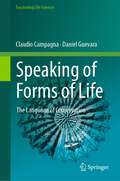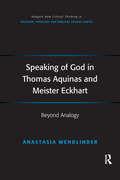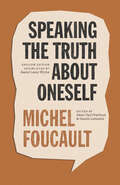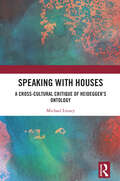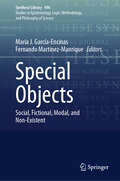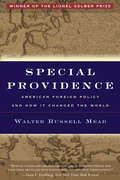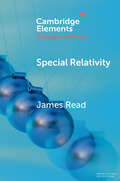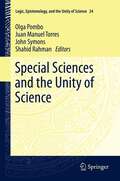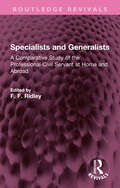- Table View
- List View
Speak Freely: Why Universities Must Defend Free Speech (New Forum Bks. #61)
by Keith E. WhittingtonWhy colleges and universities live or die by free speechFree speech is under attack at colleges and universities today, as critics on and off campus challenge the value of freewheeling debate. In Speak Freely, Keith Whittington argues that universities must protect and encourage vigorous free speech because it goes to the heart of their mission to foster freedom of thought, ideological diversity, and tolerance. Examining hot-button issues such as trigger warnings, safe spaces, hate speech, disruptive protests, speaker disinvitations, and the use of social media by faculty, Speak Freely describes the dangers of empowering campus censors to limit speech and enforce orthodoxy. It explains why universities must make space for voices from both the Left and Right. And it points out how better understanding why the university lives or dies by free speech can help guide students, faculty, administrators, and alumni when faced with unpopular, hateful, or dangerous speech. Timely and vitally important, Speak Freely shows why universities can succeed only by fostering more free speech, more free thought—and a greater tolerance for both.
Speak Freely: Why Universities Must Defend Free Speech (New Forum Books #61)
by Keith E. WhittingtonWhy free speech is the lifeblood of colleges and universitiesFree speech is under attack at colleges and universities today, with critics on and off campus challenging the value of open inquiry and freewheeling intellectual debate. Too often speakers are shouted down, professors are threatened, and classes are disrupted. In Speak Freely, Keith Whittington argues that universities must protect and encourage free speech because vigorous free speech is the lifeblood of the university. Without free speech, a university cannot fulfill its most basic, fundamental, and essential purposes, including fostering freedom of thought, ideological diversity, and tolerance. Examining such hot-button issues as trigger warnings, safe spaces, hate speech, disruptive protests, speaker disinvitations, the use of social media by faculty, and academic politics, Speak Freely describes the dangers of empowering campus censors to limit speech and enforce orthodoxy. It explains why free speech and civil discourse are at the heart of the university’s mission of creating and nurturing an open and diverse community dedicated to learning. It shows why universities must make space for voices from both the left and right. And it points out how better understanding why the university lives or dies by free speech can help guide everyone—including students, faculty, administrators, and alumni—when faced with difficult challenges such as unpopular, hateful, or dangerous speech. Timely and vitally important, Speak Freely demonstrates why universities can succeed only by fostering more free speech, more free thought—and a greater tolerance for both.
Speaking Being: Werner Erhard, Martin Heidegger, and a New Possibility of Being Human
by Bruce Hyde Drew KoppSpeaking Being: Werner Erhard, Martin Heidegger, and a New Possibility of Being Human is an unprecedented study of the ideas and methods developed by the thinker Werner Erhard. In this book, those ideas and methods are revealed by presenting in full an innovative program he developed in the 1980s called The Forum—available in this book as a transcript of an actual course led by Erhard in San Francisco in December of 1989. Since its inception, Erhard’s work has impacted the lives of millions of people throughout the world. Central to this study is a comparative analysis of Erhard’s rhetorical project, The Forum, and the philosophical project of Martin Heidegger. Through this comparative analysis, the authors demonstrate how each thinker’s work sometimes parallels and often illuminates the other. The dialogue at work in The Forum functions to generate a language which speaks being. That is, The Forum is an instance of what the authors call ontological rhetoric: a technology of communicating what cannot be said in language. Nevertheless, what does get said allows those participating in the dialogue to discover previously unseen aspects of what it currently means to be human. As a primary outcome of such discovery, access to creating a new possibility of what it is to be human is made available. The purpose of this book is to show how communication of the unspoken realm of language—speaking being—is actually accomplished in The Forum, and to demonstrate how Erhard did it in 1989. Through placing Erhard’s language use next to Heidegger’s thinking—presented in a series of “Sidebars” and “Intervals” alongside The Forum transcript—the authors have made two contributions. They have illuminated the work of two thinkers, who independently developed similar forms of ontological rhetoric while working from very different times and places. Hyde and Kopp have also for the first time made Erhard’s extraordinary form of ontological rhetoric available for a wide range of audiences, from scholars at work within a variety of academic disciplines to anyone interested in exploring the possibility of being for human beings. From the Afterword: I regard Speaking Being as an enormously important contribution to understanding Heidegger and Erhard. The latter has received far too little serious academic attention, and this book begins to make up for that lack. Moreover, the book’s analysis of Heidegger’s thought is among the best that I have ever read. I commend this book to all readers without reservation. Michael E. Zimmerman, Professor Emeritus, University of Colorado, Boulder
Speaking Freely
by Floyd AbramsThe rights guaranteed in the First Amendment—including freedom of expression—are among the fundamental touchstones of our democracy. In Speaking Freely, Floyd Abrams, who for over thirty years has been our most eloquent and respected advocate for uncensored expression, recounts some of the major cases of his remarkable career—landmark trials and Supreme Court arguments that have involved key First Amendment protections. With adversaries as diverse as Richard Nixon and Wayne Newton and allies as unlikely as Kenneth Starr, Abrams takes readers behind the scenes to explain his strategies, the ramifications of each decision, and its long-term significance, presenting a clear and compelling look at the law in action. .
Speaking Management: How to Spot Language Traps and Resolve Contested Management Terms
by Stephen Keith McGrathThis book identifies ten linguistic traps in our everyday language usage and provides philosophical justification for a method of determining internally consistent definitions of groups of related terms that avoid all ten traps. Various examples and applications of this method are given throughout. The book demonstrates how the seemingly straightforward matter of our understandings of the meaning of words can have major implications for the exercise of power. This book illustrates how this insight originated from management research into project governance that found lack of agreement on the definition of that term, as well as on many other important management terms. To resolve this, the impacts of evolution, philosophy and linguistics upon our everyday language usage were investigated. The research documented in this book found that the human tool called language works well for describing physical objects but has difficulty producing a common understanding of the meaning of concepts - a problem not restricted to the management field. That field is simply a microcosm that exposes a much more widespread linguistic usage problem affecting our personal, religious and political lives; one that existed at the time of Plato and Aristotle and has laid hidden for millennia. This book includes a lexicon of 69 commonly used but confused or contested management terms, all developed by applying its definitional method. The terms include governance, power, ethics, leadership and their associated groups of terms. The book explores how disagreement can be resolved using these new clear definitions and extends this into an analysis of who ‘good’ ethics are good for. It also incorporates a section on “how to speak management and actually know what you are talking about”, written in the style of an ‘idiots guide’ or ‘guide for dummies’. This identifies common, everyday circumstances in which lack of agreed definitions cause avoidable confusion and provides the book’s focus on conflict dissolution rather than on conflict resolution.
Speaking Out: Lectures and Speeches, 1937-1958
by Albert CamusThe Nobel Prize winner's most influential and enduring lectures and speeches, newly translated by Quintin Hoare, in what is the first English language publication of this collection. Albert Camus (1913-1960) is unsurpassed among writers for a body of work that animates the wonder and absurdity of existence. Speaking Out: Lectures and Speeches, 1938-1958 brings together, for the first time, thirty-four public statements from across Camus's career that reveal his radical commitment to justice around the world and his role as a public intellectual. From his 1946 lecture at Columbia University about humanity's moral decline, his 1951 BBC broadcast commenting on Britain's general election, and his strident appeal during the Algerian conflict for a civilian truce between Algeria and France, to his speeches on Dostoevsky and Don Quixote, this crucial new collection reflects the scope of Camus's political and cultural influence.
Speaking Politically: Adorno and Postcolonial Fiction (Routledge Research in Postcolonial Literatures)
by Eleni PhilippouIn this monograph Theodor Adorno’s philosophy engages with postcolonial texts and authors that emerge out of situations of political extremity – apartheid South Africa, war-torn Sri Lanka, Pinochet’s dictatorship, and the Greek military junta. This book is ground-breaking in two key ways: first, it argues that Adorno can speak to texts with which he is not historically associated; and second, it uses Adorno’s theory to unlock the liberatory potential of authors or novels traditionally understood to be "apolitical". While addressing Adorno’s uneven critical response and dissemination in the Anglophone literary world, the book also showcases Adorno’s unique reading of the literary text both in terms of its innate historical content and formal aesthetic attributes. Such a reading refuses to read postcolonial texts exclusively as political documents, a problematic (but changing) tendency within postcolonial studies. In short, the book operates as a two-way conversation asking: "What can Adorno’s concepts give to certain literary texts?" but also reciprocally, "What can those texts give to our conventional understanding of Adorno and his applicability?" This book is an act of rethinking the literary in Adornian terms, and rethinking Adorno through the literary.
Speaking Truth to Power - A Theory of Whistleblowing (Philosophy and Politics - Critical Explorations #6)
by Daniele Santoro Manohar KumarWhistleblowing is the public disclosure of information with the purpose of revealing wrongdoings and abuses of power that harm the public interest. This book presents a comprehensive theory of whistleblowing: it defines the concept, reconstructs its origins, discusses it within the current ethical debate, and elaborates a justification of unauthorized disclosures. Its normative proposal is based on three criteria of permissibility: the communicative constraints, the intent, and the public interest conditions. The book distinguishes between two forms of whistleblowing, civic and political, showing how they apply in the contexts of corruption and government secrecy. The book articulates a conception of public interest as a claim concerning the presumptive interest of the public. It argues that public interest is defined in opposition to corporate powers and its core content identified by the rights that are all-purposive for the distribution of social benefits. A crucial part of the proposal is dedicated to the impact of security policies and government secrecy on civil liberties. It argues that unrestrained secrecy limits the epistemic entitlement of citizens to know under which conditions their rights are limited by security policies and corporate interests. When citizens are denied the right to assess when these policies are prejudicial to their freedoms, whistleblowing represents a legitimate form of political agency that safeguards the fundamental rights of citizens against the threat of unrestrained secrecy by government power. Finally, the book contributes to shifting the attention of democratic theory from the procedures of consent formation to the mechanisms that guarantee the expression of dissent. It argues that whistleblowing is a distinctive form of civil dissent that contributes to the demands of institutional transparency in constitutional democracies and explores the idea that the way institutions are responsive to dissent determines the robustness of democracy, and ultimately, its legitimacy. What place dissenters have within a society, whether they enjoy personal safety, legal protection, and safe channels for their disclosure, are hallmarks of a good democracy, and of its sense of justice.
Speaking Words of Wisdom: The Beatles and Religion (American Music History)
by Michael McGowan“More popular than Jesus.”Despite the uproar it caused in America in 1966, John Lennon’s famous assessment of the Beatles vis-à-vis religion was not far off. The Beatles did mean more to kids than the religions in which they were raised, not only in America but everywhere in the world.By all accounts, the Beatles were the most significant musical group of the twentieth century. Their albums sold in the hundreds of millions, and the press was always eager to document their activities and perspectives. And when fan appreciation morphed into worship, Beatlemania took on religious significance. Many young people around the world began to look to the Beatles—their music, their commentary, their art—for meaning in a turbulent decade. Speaking Words of Wisdom is a deep dive into the Beatles’ relationship to religion through the lenses of philosophy, cultural studies, music history, and religious studies. Chapters explore topics such as religious life in Liverpool, faith among individual band members, why and how India entered the Beatles’ story, fan worship/deification, and the Beatles’ long-lasting legacy. In the 1960s, the Beatles facilitated a reevaluation of our deepest values. The story of how the Beatles became modern-day sages is an important case study for the ways in which consumers make culturally and religiously significant meaning from music, people, and events.In addition to the editor, the contributors to this book include David Bedford, Kenneth Campbell, John Covach, Melissa Davis, Anthony DeCurtis, Mark Duffett, Scott Freer, Murray Leeder, Sean MacLeod, Grant Maxwell, Christiane Meiser, and Eyal Regev.
Speaking about Torture
by Elisabeth Weber Julie A. CarlsonThis collection of essays is the first book to take up the urgent issue of torture from the array of approaches offered by the arts and humanities. In the post-9/11 era, where we are once again compelled to entertain debates about the legality of torture, this volume speaks about the practice in an effort to challenge the surprisingly widespread acceptance of state-sanctioned torture among Americans, including academics and the media–entertainment complex. Speaking about Torture also claims that the concepts and techniques practiced in the humanities have a special contribution to make to this debate, going beyond what is usually deemed a matter of policy for experts in government and the social sciences. It contends that the way one speaks about torture—including that one speaks about it—is key to comprehending, legislating, and eradicating torture. That is, we cannot discuss torture without taking into account the assaults on truth, memory, subjectivity, and language that the humanities theorize and that the experience of torture perpetuates. Such accounts are crucial to framing the silencing and demonizing that accompany the practice and representation of torture.Written by scholars in literary analysis, philosophy, history, film and media studies, musicology, and art history working in the United States, Europe, and the Middle East, the essays in this volume speak from a conviction that torture does not work to elicit truth, secure justice, or maintain security. They engage in various ways with the limits that torture imposes on language, on subjects and community, and on governmental officials, while also confronting the complicity of artists and humanists in torture through their silence, forms of silencing, and classic means of representation. Acknowledging this history is central to the volume’s advocacy of speaking about torture through the forms of witness offered and summoned by the humanities.
Speaking by the Numbers: Enneagram Wisdom for Teachers, Pastors, and Communicators
by Sean PalmerIt's not just what you say, but how you say it.Speaking by the Numbers
Speaking for Buddhas: Scriptural Commentary in Indian Buddhism
by Richard NanceBuddhist intellectual discourse owes its development to a dynamic interplay between primary source materials and subsequent interpretation, yet scholarship on Indian Buddhism has long neglected to privilege one crucial series of texts. Commentaries on Buddhist scriptures, particularly the sutras, offer rich insights into the complex relationship between Buddhist intellectual practices and the norms that inform-and are informed by-them. Evaluating these commentaries in detail for the first time, Richard F. Nance revisits-and rewrites&mdashthe critical history of Buddhist thought, including its unique conception of doctrinal transmission.Attributed to such luminaries as Nagarjuna, Vasubandhu, Dignaga, and Santideva, scriptural commentaries have long played an important role in the monastic and philosophical life of Indian Buddhism. Nance reads these texts against the social and cultural conditions of their making, establishing a solid historical basis for the interpretation of key beliefs and doctrines. He also underscores areas of contention, in which scholars debate what it means to speak for, and as, a Buddha. Throughout these texts, Buddhist commentators struggle to deduce and characterize the speech of Buddhas and teach others how to convey and interpret its meaning. At the same time, they demonstrate the fundamental dilemma of trying to speak on behalf of Buddhas. Nance also investigates the notion of "right speech" as articulated by Buddhist texts and follows ideas about teaching as imagined through the common figure of a Buddhist preacher. He notes the use of epistemological concepts in scriptural interpretation and the protocols guiding the composition of scriptural commentary, and provides translations of three commentarial guides to better clarify the normative assumptions organizing these works.
Speaking for Others: The Ethics of Informal Political Representation
by Wendy SalkinA political philosopher dissects the duties and dilemmas of the unelected spokesperson, from Martin Luther King, Jr., to Greta Thunberg.Political representation is typically assumed to be the purview of formal institutions and elected officials. But many of the people who represent us are not senators or city councilors—think of Martin Luther King, Jr., or Malala Yousafzai or even a neighbor who speaks up at a school board meeting. Informal political representatives are in fact ubiquitous, often powerful, and some bear enormous responsibility. In Speaking for Others, political philosopher Wendy Salkin develops the first systematic conceptual and moral analysis of informal political representation.Salkin argues that informal representation can be a political lifeline, particularly for oppressed and marginalized groups that are denied representation in formal political institutions. Yet informal political representatives exert outsized influence over the ways these groups’ interests are understood by the public, without the represented having much recourse to hold them accountable. And many informal political representatives are selected not by the groups they represent but by outsiders, sticking these groups with representatives they would not choose but cannot shake. The role of informal political representatives is therefore fraught with moral questions. What exactly are their duties and to whom are they owed? Should they be members of the groups they represent? When is informal representation permissible and when is it best avoided?Informal political representation is taking place all around us. In fact, you yourself may be an informal political representative without knowing it. Speaking for Others explores the tensions central to this pervasive yet underexamined practice, bringing light to both its perils and its promise.
Speaking in Tongues
by J. M. Coetzee Mariana DimópulosLit Hub’s Most Anticipated Books of 2025 In this provocative dialogue, a Nobel laureate novelist and a leading translator investigate the nature of language and the challenges of translation. “An intelligent, moving, and supremely humane act of criticism that reveals just how difficult and wondrous it can be to inhabit a language that is not your own.” — Merve Emre Language, historically speaking, has always been slippery. Two dictionaries provide two different maps of the universe: which one is true, or are both false? Speaking in Tongues—taking the form of a dialogue between Nobel laureate novelist J. M. Coetzee and eminent translator Mariana Dimópulos—examines some of the most pressing linguistic issues that plague writers and translators well into the twenty-first century. The authors address questions that we must answer in order to understand contemporary society. They inquire if one can truly love an acquired language, and they question why certain languages, like Spanish, have gender differences built into them. They examine the threat of monolingualism and ask how we can counter, if at all, the global spread of the English language, which seems to maraud like a colonial power. They question whether it should be the duty of the translator to remove morally objectionable, misogynistic, or racist language. And in the conclusion, Coetzee even speculates whether it’s only mathematics that can tell the truth about everything. Drawing from decades of experience in the craft of language, both Dimópulos and Coetzee face the reality, as did Walter Benjamin over a century ago in his seminal essay “The Task of the Translator,” that when it comes to self-expression, some things will always get lost in translation. Speaking in Tongues finally emerges as an engaging and accessible work of philosophy, shining a light on some of the most important linguistic and philological issues of our time.
Speaking into the Air: A History of the Idea of Communication
by John Durham PetersCommunication plays a vital and unique role in society-often blamed for problems when it breaks down and at the same time heralded as a panacea for human relations. A sweeping history of communication, Speaking Into the Air illuminates our expectations of communication as both historically specific and a fundamental knot in Western thought. "This is a most interesting and thought-provoking book. . . . Peters maintains that communication is ultimately unthinkable apart from the task of establishing a kingdom in which people can live together peacefully. Given our condition as mortals, communication remains not primarily a problem of technology, but of power, ethics and art." —Antony Anderson, New Scientist "Guaranteed to alter your thinking about communication. . . . Original, erudite, and beautifully written, this book is a gem." —Kirkus Reviews "Peters writes to reclaim the notion of authenticity in a media-saturated world. It's this ultimate concern that renders his book a brave, colorful exploration of the hydra-headed problems presented by a rapid-fire popular culture." —Publishers Weekly What we have here is a failure-to-communicate book. Funny thing is, it communicates beautifully. . . . Speaking Into the Air delivers what superb serious books always do-hours of intellectual challenge as one absorbs the gradually unfolding vision of an erudite, creative author." —Carlin Romano, Philadelphia Inquirer
Speaking of Forms of Life: The Language of Conservation (Fascinating Life Sciences)
by Daniel Guevara Claudio CampagnaHumans pose an unprecedented threat to life in all its great diversity of forms. The human-induced extinction rate has been compared to “mass extinctions” of the past. But this language masks the fact that the crisis is due to voluntary, and thus, avoidable choices and actions. “Speaking of Forms of Life” shows that at the root of this crisis is the tragic inadequacy of the language predominantly used to represent and address what we are doing, including the language of “sustainable development,” “rights” for animals and the rest of nature, their “intrinsic value,” and conservation of species as “populations.” This talk alienates us from the other living things, from what they actually are, have and do, and it perpetuates the harm and loss. Campagna and Guevara compellingly argue, on rigorous but accessible grounds, that there is an alternative language to guide conservation, in confronting the radically urgent, ethical issues it faces. This is a language with which we are all familiar, mastered by naturalists, from Aristotle to Audubon. It articulates the primary value in life and the standard that must guide how human beings should live, as one form of life, among countless others. This book is a homecoming for those who practice conservation to, above all else, secure a creature’s ability to satisfy the necessities of its form of life.
Speaking of God in Thomas Aquinas and Meister Eckhart: Beyond Analogy (Routledge New Critical Thinking in Religion, Theology and Biblical Studies)
by Anastasia WendlinderMedieval masters Thomas Aquinas and Meister Eckhart considered problems inherent to speaking of God, exploring how religious language might compromise God's transcendence or God's immanence ultimately hindering believers in their journey of faith seeking understanding. Going beyond ordinary readings of Aquinas and building a foundation for further insights into the works of both theologians, this book draws out the implications of the thought of Eckhart and Aquinas for contemporary issues, including ecumenical and inter-religious dialogue, liturgy and prayer, and religious inclusivity. Reading Aquinas and Eckhart in light of each other reveals the profound depth and orthodoxy of both of these scholars and provides a novel approach to many theological and practical religious issues.
Speaking the Truth about Oneself: Lectures at Victoria University, Toronto, 1982 (The Chicago Foucault Project)
by Michel FoucaultNow in paperback, this collection of Foucault’s lectures traces the historical formation and contemporary significance of the hermeneutics of the self. Just before the summer of 1982, French philosopher Michel Foucault gave a series of lectures at Victoria University in Toronto. In these lectures, which were part of his project of writing a genealogy of the modern subject, he is concerned with the care and cultivation of the self, a theme that becomes central to the second, third, and fourth volumes of his History of Sexuality. Foucault had always been interested in the question of how constellations of knowledge and power produce and shape subjects, and in the last phase of his life, he became especially interested not only in how subjects are formed by these forces but in how they ethically constitute themselves. In this lecture series and accompanying seminar, Foucault focuses on antiquity, starting with classical Greece, the early Roman empire, and concluding with Christian monasticism in the fourth and fifth centuries AD. Foucault traces the development of a new kind of verbal practice—“speaking the truth about oneself”—in which the subject increasingly comes to be defined by its inner thoughts and desires. He deemed this new form of “hermeneutical” subjectivity important not just for historical reasons, but also due to its enduring significance in modern society.
Speaking with Houses: A Cross-Cultural Critique of Heidegger’s Ontology
by Michael LinzeyThis book critically examines the concept of “Being” in Western philosophy and its manifestation in architecture.The book traverses diverse cultural and historical contexts, analysing five architectural works: the Djoser Step Pyramid in ancient Egypt, the Pantheon in imperial Rome, the Tai-an tea house in late medieval Japan, the Te Tokanganui-a-Noho meeting house in colonial New Zealand and Mies van der Rohe’s Seagram Building in modern New York. Through these case studies, it challenges Martin Heidegger’s assertion that “language is the house of Being,” proposing instead that “Being” is a construct specific to Western ontology. By exploring architectural poiesis across various cultures, the book reveals that the Western notion of “Being” is not a universal foundation for architectural creation. Each examined structure embodies distinct cultural and philosophical principles, such as the concept of mū in Japanese tea houses, which signifies “neither Being nor non-Being,” and the “no-Being” tradition in Māori tikanga. This comparative analysis underscores the diversity of architectural expressions and their underlying philosophies, offering readers a nuanced understanding of how different cultures conceptualize existence and space.This book is an invaluable resource for scholars in architecture, philosophy and cultural studies. Its interdisciplinary approach provides a comprehensive critique of Western metaphysical assumptions, encouraging readers to reconsider the relationship between language, being, and architectural form. By integrating architectural analysis with philosophical inquiry, it fosters a deeper appreciation of cultural diversity in architectural practices and invites academics to explore alternative ontological perspectives in the built environment.
Special Objects: Social, Fictional, Modal, and Non-Existent (Synthese Library #496)
by Maria J. García-Encinas Fernando Martínez-ManriqueThis book proposes a different perspective on actual queries within the field of ontology. Focusing on non-standard objects, it offers original answers to classic problems in metaphysics, such as individuation, reference, existence and non-existence. The chosen ontological fields are, for this purpose, ontologies that essentially involve human social practices such as intentional objects, fictions, mental illnesses or social entities. Even though the papers can be read independently, readers will discover a number of original intersections that provide fresh points of entry to contemporary metaphysical issues. By dealing with entities that are not so frequently addressed in related works, the book also contributes to broaden their perspective on ontology. Both scholars and students will find it particularly useful to have a survey about non-standard abstract entities that can provide new topics for their research.
Special Olympics Oral History Volume 4: Different Stories but One Effort (Economy and Social Inclusion)
by William P. Alford Mei Liao Fengming CuiThis open access book commemorates the 50th anniversary of the Special Olympics (1968-2018). This is the fourth volume of the first oral history about people with intellectual disabilities in the world and the first oral history of persons with disabilities in China. This book also includes stories from teachers, coaches, school principals, parent leaders, coworkers, and volunteers. They share their personal views on people with intellectual disabilities. The book also includes observations and records of what people with intellectual disabilities and others do on a certain day. It uses sociology and oral history to give an objective, neutral account of the lives of people with intellectual disabilities in China. It helps readers understand how the Special Olympics movement, public policies, social environment, and self-cognition affect people with intellectual disabilities.
Special Providence: American Foreign Policy and How It Changed the World
by Walter Russell Mead"God has a special providence for fools, drunks and the United States of America."--Otto von BismarckAmerica's response to the September 11 attacks spotlighted many of the country's longstanding goals on the world stage: to protect liberty at home, to secure America's economic interests, to spread democracy in totalitarian regimes and to vanquish the enemy utterly.One of America's leading foreign policy thinkers, Walter Russell Mead, argues that these diverse, conflicting impulses have in fact been the key to the U.S.'s success in the world. In a sweeping new synthesis, Mead uncovers four distinct historical patterns in foreign policy, each exemplified by a towering figure from our past.Wilsonians are moral missionaries, making the world safe for democracy by creating international watchdogs like the U.N. Hamiltonians likewise support international engagement, but their goal is to open foreign markets and expand the economy. Populist Jacksonians support a strong military, one that should be used rarely, but then with overwhelming force to bring the enemy to its knees. Jeffersonians, concerned primarily with liberty at home, are suspicious of both big military and large-scale international projects.A striking new vision of America's place in the world, Special Providence transcends stale debates about realists vs. idealists and hawks vs. doves to provide a revolutionary, nuanced, historically-grounded view of American foreign policy.
Special Relativity (Elements in the Philosophy of Physics)
by James ReadThis Element presents the philosophy of special relativity: from the foundations of the theory in Newtonian mechanics, through its birth out of the ashes of 19th Century ether theory, through the various conceptual paradoxes which the theory presents, and finally arriving at some of its connections with Einstein's later theory of general relativity. It illustrates concepts such as inertial frames, force-free motion, and dynamical versus geometrical understandings of physics, the standard hierarchy of classical spacetimes, the concept of a symmetry of a physical theory, Poincaré invariant, Einstein's 1905 derivation of the Lorentz transformations, spacetime structure from Aristotle to Minkowski, general covariance, dynamical and geometrical approaches to spacetime, the conventionality of simultaneity, Frame-dependent effects, and the twin paradox.
Special Sciences and the Unity of Science
by Shahid Rahman Olga Pombo John Symons Juan Manuel TorresScience is a dynamic process in which the assimilation of new phenomena, perspectives, and hypotheses into the scientific corpus takes place slowly. The apparent disunity of the sciences is the unavoidable consequence of this gradual integration process. Some thinkers label this dynamical circumstance a 'crisis'. However, a retrospective view of the practical results of the scientific enterprise and of science itself, grants us a clear view of the unity of the human knowledge seeking enterprise. This book provides many arguments, case studies and examples in favor of the unity of science. These contributions touch upon various scientific perspectives and disciplines such as: Physics, Computer Science, Biology, Neuroscience, Cognitive Psychology, and Economics.
Specialists and Generalists: A Comparative Study of the Professional Civil Servant at Home and Abroad (Routledge Revivals)
by F. F. RidleyOriginally published in 1968, this book provides surveys of the Australian, French, German, Swedish and American systems of public administration. Previously unpublished material on the professional classes in Britain was made available which filled a gap in the (then) available textbooks on British government. A concluding chapter deals with the wider aspects of the generalist versus specialist problem, an original contribution to administrative theory. The book will be of interest to students of politics and government and the student of comparative administration, as well as to those concerned with civil service reform
